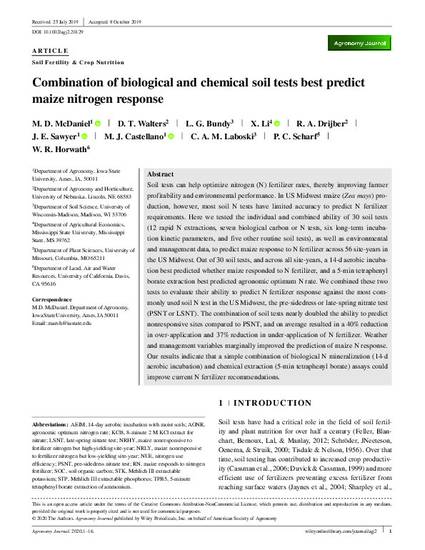
Soil tests can help optimize nitrogen (N) fertilizer rates, thereby improving farmer profitability and environmental performance. In US Midwest maize (Zea mays) production, however, most soil N tests have limited accuracy to predict N fertilizer requirements. Here we tested the individual and combined ability of 30 soil tests (12 rapid N extractions, seven biological carbon or N tests, six long‐term incubation kinetic parameters, and five other routine soil tests), as well as environmental and management data, to predict maize response to N fertilizer across 56 site‐years in the US Midwest. Out of 30 soil tests, and across all site‐years, a 14‐d aerobic incubation best predicted whether maize responded to N fertilizer, and a 5‐min tetraphenyl borate extraction best predicted agronomic optimum N rate. We combined these two tests to evaluate their ability to predict N fertilizer response against the most commonly used soil N test in the US Midwest, the pre‐sidedress or late‐spring nitrate test (PSNT or LSNT). The combination of soil tests nearly doubled the ability to predict nonresponsive sites compared to PSNT, and on average resulted in a 40% reduction in over‐application and 37% reduction in under‐application of N fertilizer. Weather and management variables marginally improved the prediction of maize N response. Our results indicate that a simple combination of biological N mineralization (14‐d aerobic incubation) and chemical extraction (5‐min tetraphenyl borate) assays could improve current N fertilizer recommendations.
Available at: http://works.bepress.com/castellano-michael/55/

This article is published as McDaniel, M. D., D. T. Walters, L. G. Bundy, X. Li, R. A. Drijber, J. E. Sawyer, M. J. Castellano, C. A. M. Laboski, P. C. Scharf, and W. R. Horwath. "Combination of biological and chemical soil tests best predict maize nitrogen response." Agronomy Journal (2020). doi: 10.1002/agj2.20129.